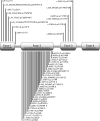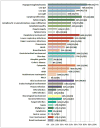Phenotype, penetrance, and treatment of 133 cytotoxic T-lymphocyte antigen 4-insufficient subjects
- PMID: 29729943
- PMCID: PMC6215742
- DOI: 10.1016/j.jaci.2018.02.055
Phenotype, penetrance, and treatment of 133 cytotoxic T-lymphocyte antigen 4-insufficient subjects
Abstract
Background: Cytotoxic T-lymphocyte antigen 4 (CTLA-4) is a negative immune regulator. Heterozygous CTLA4 germline mutations can cause a complex immune dysregulation syndrome in human subjects.
Objective: We sought to characterize the penetrance, clinical features, and best treatment options in 133 CTLA4 mutation carriers.
Methods: Genetics, clinical features, laboratory values, and outcomes of treatment options were assessed in a worldwide cohort of CTLA4 mutation carriers.
Results: We identified 133 subjects from 54 unrelated families carrying 45 different heterozygous CTLA4 mutations, including 28 previously undescribed mutations. Ninety mutation carriers were considered affected, suggesting a clinical penetrance of at least 67%; median age of onset was 11 years, and the mortality rate within affected mutation carriers was 16% (n = 15). Main clinical manifestations included hypogammaglobulinemia (84%), lymphoproliferation (73%), autoimmune cytopenia (62%), and respiratory (68%), gastrointestinal (59%), or neurological features (29%). Eight affected mutation carriers had lymphoma, and 3 had gastric cancer. An EBV association was found in 6 patients with malignancies. CTLA4 mutations were associated with lymphopenia and decreased T-, B-, and natural killer (NK) cell counts. Successful targeted therapies included application of CTLA-4 fusion proteins, mechanistic target of rapamycin inhibitors, and hematopoietic stem cell transplantation. EBV reactivation occurred in 2 affected mutation carriers after immunosuppression.
Conclusions: Affected mutation carriers with CTLA-4 insufficiency can present in any medical specialty. Family members should be counseled because disease manifestation can occur as late as 50 years of age. EBV- and cytomegalovirus-associated complications must be closely monitored. Treatment interventions should be coordinated in clinical trials.
Keywords: Cytotoxic T-lymphocyte antigen 4; abatacept; autoimmunity; common variable immunodeficiency; hematopoietic stem cell transplantation; hypogammaglobulinemia; immune dysregulation; primary immunodeficiency; sirolimus.
Copyright © 2018 American Academy of Allergy, Asthma & Immunology. All rights reserved.
Figures






Comment in
-
Immunosuppression for immunodeficiency: Getting smarter.J Allergy Clin Immunol. 2018 Dec;142(6):1762-1764.e1. doi: 10.1016/j.jaci.2018.10.006. Epub 2018 Oct 17. J Allergy Clin Immunol. 2018. PMID: 30339850 No abstract available.
References
Publication types
MeSH terms
Substances
Grants and funding
- 207556/Z/17/Z/WT_/Wellcome Trust/United Kingdom
- BB/H013598/2/BB_/Biotechnology and Biological Sciences Research Council/United Kingdom
- R01 AI085090/AI/NIAID NIH HHS/United States
- R34 AI106570/AI/NIAID NIH HHS/United States
- BB/H013598/1/BB_/Biotechnology and Biological Sciences Research Council/United Kingdom
LinkOut - more resources
Full Text Sources
Other Literature Sources
Medical

